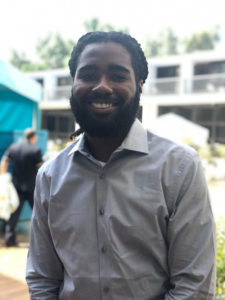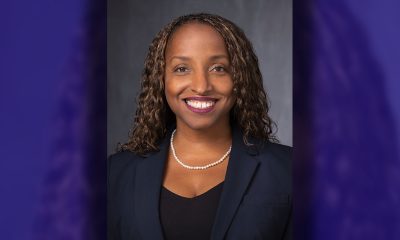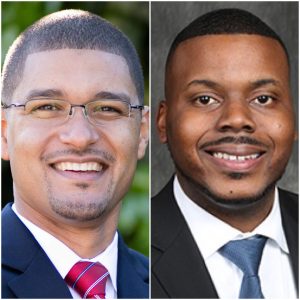New Orleans Data News Weekly
Baby Dolls Reflect on their Unique Tradition in Mardi Gras
NEW ORLEANS DATA NEWS WEEKLY — The Baby Dolls emerged in segregated areas around Uptown, then became a mainstay during Mardi Gras around 1912.
By Edward Carter, III
The Baby Dolls emerged in segregated areas around Uptown, then became a mainstay during Mardi Gras around 1912, and are now known to be one of the first women’s masking organizations in the city, even the country. It is a group that is considered a sisterhood, supporting women’s empowerment, that still exists. For Black History Month, Southern University at New Orleans paid tribute to the legacy of the Baby Dolls as it marked “African American Carnival History” on Feb. 25.
The event brought local baby dolls Connie Abdul-Salaam, Diane Honoré, Merline Kimble, Rosaline Theodore and Denise Trepagnier together with Kim Vaz-Deville, the author of “Walking Raddy: The Baby Dolls of New Orleans” who is a professor of Education and the associate dean of the College of Arts and Sciences at Xavier University.
“My grandmother said masking Baby Dolls was the most fun she had in her entire life,” said Merline “The Gold Digger” Kimble, the granddaughter of an original “Gold Digger” Baby Doll. She said that she grew up watching her grandmother happy and having fun masking, and that sense of joy intrigued her about the tradition.
“And if this was the most fun time she was having in her life, then I was interested,” she said. Kimble said this first hand experience is what got her excited about masking Baby Dolls.
“Once you put on the costume, that Baby Doll costume, you are no longer shy, you are no longer camera shy and you really enjoy it,” said Baby Doll Denise Trepagnier.
Current Baby Dolls said they continue to maintain the practice the way the original Baby Dolls did. The celebration of womanhood and sisterhood and the freedom to express themselves during Mardi Gras is a tradition they want to pass on to future Baby Dolls, they said.
“I’d like to see more of our youth masking and costuming. I’d like to see our children enjoy Mardi Gras as we did,” Trepagnier said. “I’d like to see the Mardi Gras come back to when it was families,” she added.
They acknowledged that while some things are changing today for traditional masking, they believe the essence of the Baby Dolls in the community is something that is still relevant today.
“The whole thing is about comradery and giving back to the community,” said Baby Doll Dianne “Gumbo Marie” Honoré. “We come together and we share that same spirit,” she said.
Most Baby Dolls work to improve the community year round and not just during Mardi Gras. Honoré, for instance, is the founder of the Amazons, a group who participates in community service and charity work. Vaz Deville, who has written about the Baby Dolls, emphasized that despite decades since they started, it was still important for the public to know what the Baby Dolls represent.
“It is something that is over 100 years old. It is a way that people express themselves and for them to know they are important. It is a way for them to make their neighbors have a good time because their neighbors weren’t included in Mardi Gras,” Vaz-Deville explained.
#NNPA BlackPress
New Orleans Residents Respond to the Spread of the Coronavirus
NEW ORLEANS DATA NEWS WEEKLY — “We just finished Mardi Gras season with hundreds of thousands of people visiting our city. I pray that no one has brought the virus here,” said Tyler Townsend, a senior biology major at Xavier University of Louisiana, who is a native of Los Angeles, Calif. “It’s like we were an open target for the coronavirus,” Townsend said, given the city’s many festivals and events that attract tourists from all over the world. “I am ready for the coronavirus, but it is no secret that I am still nervous about it as well,” he added.
 By Jordan Deloch, Data News Weekly Contributor
By Jordan Deloch, Data News Weekly Contributor
Over the span of January to March, in response to the worldwide spread of coronavirus (COVID-19), U.S. citizens say they are now increasing their awareness about the virus and finding ways to prevent its spreading. World health officials place the total number of infected persons at over 100,000 people with over 3,802 deaths. In the United States, the Centers for Disease Control and Prevention has reported around 400 cases in 33 states, with 21 deaths. The states with the most cases reported are Washington State, New York, and California. As of the first week of March, no known cases have been reported in Louisiana, however, in neighboring Texas, there have been eight reported cases of positive testing.
“The coronavirus is honestly scary. There is no telling how and when the virus can be spread to our city,” said Christina Williams, an Uptown, New Orleans resident and youth mentor. “Nor is there a way to know what has caused this virus,” Williams said, adding that: “The fact that this virus could come, and people not know about it is nerve-wrecking.”
 Workers in the city said that many workplaces have restricted travel for employees, and schools have sent notifications to parents of the possible threat that the virus poses, and to encourage enhanced hygiene.
Workers in the city said that many workplaces have restricted travel for employees, and schools have sent notifications to parents of the possible threat that the virus poses, and to encourage enhanced hygiene.
“We just finished Mardi Gras season with hundreds of thousands of people visiting our city. I pray that no one has brought the virus here,” said Tyler Townsend, a senior biology major at Xavier University of Louisiana, who is a native of Los Angeles, Calif. “It’s like we were an open target for the coronavirus,” Townsend said, given the city’s many festivals and events that attract tourists from all over the world. “I am ready for the coronavirus, but it is no secret that I am still nervous about it as well,” he added.
The increase in concern about the spread of the virus to each state has led to a shortage of face masks, hand sanitizers and household cleaning products at major retail outlets in the city, residents noted.
“The coronavirus is real and spreading, but I don’t really know what more there is for me to do except playing my part by washing my hands and being mindful of my daily activity in terms of hygiene,” said Shania Campbell, a Dillard University student. “People are afraid of this virus, but in reality, there are so many other dangers at hand. Everything needs awareness, not just this,” Campbell said.
While some residents said they are taking new precautions, others said they are used to preparedness and disruptions to the routine that come with other hazards the city faces each year.
 “Being the normally hygienically aware individual that I always am, any other efforts are speculative at best,” said Percy Marchand, a Mid-City resident and business owner. “Also, I am stocked up on goods just in case, but again, living in New Orleans, we are always stocked up and prepared for a disaster,” Marchand said.
“Being the normally hygienically aware individual that I always am, any other efforts are speculative at best,” said Percy Marchand, a Mid-City resident and business owner. “Also, I am stocked up on goods just in case, but again, living in New Orleans, we are always stocked up and prepared for a disaster,” Marchand said.
Residents said they felt some attention has been taken away from yearly viruses such as the flu, which is the more prominent virus of the two. For Louisiana, while there have not been any reported cases of the coronavirus, the virus is still being spread in the midst of influenza season, which runs from October to April. Last year, state officials reported that there were 14,000 hospitalizations and around 1,400 deaths from the flu.
“Honestly, I’m not really worried about the virus. To me, it’s just another running case of something to be worried about,” said Ernest Lumpkins, an Uptown New Orleans resident. “Every year, it’s something different. Before it was the Swine Flu (H1N1), now it’s this. This doesn’t bother me at all,” Lumpkins added.
Still residents said they will continue to take steps to protect themselves and their families.
“All measures of safety are appreciated. This is a serious time and nothing to play with,” said Marianne Alexis, a New Orleans East resident. “You can never be too safe. I take precautions every day by washing my hands and being aware of my surroundings,” Alexis added.
This article originally appeared in New Orleans Data News Weekly.
#NNPA BlackPress
Bike Ride Highlights the 170 Miles that Separates Families between New Orleans and Angola
NEW ORLEANS DATA NEWS WEEKLY — It’s a system that takes a toll on families the most. In a country that has the largest prison population and the highest per-capita incarceration rate in the world, around 93.2 percent of the approximately 185,500 federal inmates are men. Seven percent are women. Around 40 percent are African Americans.
By Edward Carter III
It’s a system that takes a toll on families the most.
In a country that has the largest prison population and the highest per-capita incarceration rate in the world, around 93.2 percent of the approximately 185,500 federal inmates are men. Seven percent are women. Around 40 percent are African Americans.
The location of state penitentiaries also makes it difficult for inmates to see their families regularly. In other cases, inmates are transported to different states and the distance has heightened the challenge for families to stay connected during incarceration. In New Orleans, it’s a 170-mile journey from the city to the Louisiana State Penitentiary in West Feliciana Parish called Angola, named after the former plantation, it now occupies. On October 18, families and advocates sought to support families who wish to stay connected to incarcerated loved ones by raising funds through the Nola to Angola Annual Bike Ride.
“I spent 32 years incarcerated and through that course of 32 years I learned a lot about the importance of visitation,” said Leo Jackson, the founder of Nola to Angola, now in its 9th year. “There were times where my family couldn’t visit me because my parents couldn’t make that long journey to Angola,” he said.
Jackson kicked off the bike ride at Municipal Court at Tulane and Broad Avenues, the place where many separations begin. The Bike Riding Program raises money for transportation provided by the Cornerstone Bus Project so that families of incarcerated individuals can have a means to regularly visit their loved ones. Over 70 riders’ cycle from New Orleans to Angola to demonstrate the distance of the trip and to raise awareness to support programs like the bus project to keep families connected during incarceration. The goal of Nola to Angola is to raise $50,000 or more so inmates can see their families regularly through the Free Bus Program.
The riders included not just local citizens but previous inmates who shared that their situation was very similar when their families weren’t able to visit them. They commit to making the 170-mile trip, which takes them a total of three days.
“This bike ride is one of those things that brings awareness to what we need to do in order to bring equity in our Criminal Justice System,” said Rob Richardson, one of this year’s Nola to Angola riders.
Richardson, who served a 21-year-sentence at Angola said after he was released in 2018, the bike ride became very sentimental to him as he makes the trip back to the place he was incarcerated in support of those still serving terms and understanding the toll for families.
“I want to represent those 6,000-plus men that are housed in the Angola State Penitentiary alone and to give back to just short of 40,000 incarcerated men and women throughout our state,” Richardson said.
The free bus trips have become a space for families of the incarcerated to support each other both emotionally and logistically during the separations. Rob’s wife, Fox Richardson, also told residents at the start of this year’s bike ride about the feeling she had when her husband was incarcerated.
“When you’re fighting for your family when you know that you have been done wrong by a system that is supposed to be about justice. When that system commits an act of violence against your family and injustice against you, it’s a hard role to hold,” said Fox Richardson, one of this year’s Nola to Angola riders.
It was not easy for Fox Richardson to raise six sons with the absence of their father due to incarceration, she said. She kept hope and made sure her children still had a relationship with their father even due to the disadvantages of Rob being in prison for most of their upbringing.
“Love is the most divine chemical in the universe,” said Fox Richardson. “The love that we shared as a family sustained us to make it through the most difficult situations. And to continue to give faith and hope to our six sons that one day their father was going to come home. It was a moment for me,” Richardson said.
This experience allows citizens to get insights on what it feels like to be in a penitentiary and gives former inmates a recap and remembrance of the feeling to continue to make a difference for other families when they get out.
“And that is what this Nola to Angola is about. It’s about bringing families together and letting nothing stop love, not even prison walls,” she added.
This article originally appeared in New Orleans Data News Weekly.
#NNPA BlackPress
Nigerian Artist Nike Okundaye shares Textile Art in New Orleans
NEW ORLEANS DATA NEWS WEEKLY — Textile Artist Oyenike Monica Okundaye, better known as Nike Okundaye, displayed the unique adire designs of the Yoruba Artform during a stay in New Orleans, hosted by Xavier University of Louisiana. Okundaye is the owner and curator of Nike Art Galleries in Lagos, considered one of the largest of its kind in West Africa, as well as other art centers in Osogbo, Ogidi-Ijumu, and Abuja, Nigeria.
By Daylan Paige
Textile Artist Oyenike Monica Okundaye, better known as Nike Okundaye, displayed the unique adire designs of the Yoruba Artform during a stay in New Orleans, hosted by Xavier University of Louisiana. Okundaye is the owner and curator of Nike Art Galleries in Lagos, considered one of the largest of its kind in West Africa, as well as other art centers in Osogbo, Ogidi-Ijumu, and Abuja, Nigeria.
Her work showcases the Adire Tradition of Indigo Dyeing Textile Process in Southwestern Nigeria that can be traced back to West African civilizations. Adire translates to “tied and dyed” that creates patterns that are identifiable looks for West African textiles.

Photo by: Daylan Paige
“I was taken by the way that she had come from poverty and used art not only to empower herself but to empower the people around her, especially rural women who didn’t have a lot of education and didn’t have the means to have an income,” said Dr. Kim Vaz-Deville, the Associate Dean of the College of Arts and Sciences at Xavier. Okundaye wrote about her work in a 2001 book “Beyond Indigo: Adire Eleko Squares, Patterns & Meanings.”
Okundaye’s story of using art to empower women is what attracted Vaz-Deville to her work and to bringing her to New Orleans. Vaz profiled Okundaye’s story in her book “The Woman with the Artistic Brush: A Life History of Yoruba Batik Artist Nike Davies.”
Okundaye started her career in 1968 in a small art shop.
“My inspiration comes directly from my dreams, being born as an artist, I get inspiration from my own direct background,” Okundaye said. She has since trained over 4,000 people to become artists since 1968. She also has more than 150 students in Europe and North America. Another Nigerian Artist Ayoola Omovo visiting New Orleans and the exhibit titled “Insight” said that Okundaye has created a pathway for generations after her.

Photo by: Daylan Paige
“Nike inspired me in a very unique way, she supports women and she’s a vibrant artist and no matter her age she keeps working every day. As a woman she inspires girls to do what they want for as long as you want,” Omovo said.
Okundaye said she looks forward to sharing with Xavier students the origins of her work and to inspire other female artists to create textiles.
“When I came to Xavier, I say this university especially really makes me grin. This is my first time having an opportunity to exhibit some of my female artists and people from my gallery, so this is a great achievement, so I thank the organizer, Dr. Kim,” Okundaye said.
Vaz-Deville said that Okundaye’s work has taught those who follow her how art can reflect heritage, community, and ingenuity.
“Art is life. Creativity is like the bubbling brook that’s inside all of us and if we don’t tend to that creativity, we become dried up in a way,” Vaz-Deville said.
This article originally appeared in New Orleans Data News Weekly.
-

 Activism4 weeks ago
Activism4 weeks agoOakland Post Endorses Barbara Lee
-

 Activism4 weeks ago
Activism4 weeks agoOakland Post: Week of March 28 – April 1, 2025
-

 Activism3 weeks ago
Activism3 weeks agoOakland Post: Week of April 2 – 8, 2025
-

 #NNPA BlackPress3 weeks ago
#NNPA BlackPress3 weeks agoTrump Profits, Black America Pays the Price
-

 Activism2 weeks ago
Activism2 weeks agoOakland Post: Week of April 9 – 15, 2025
-

 #NNPA BlackPress3 weeks ago
#NNPA BlackPress3 weeks agoHarriet Tubman Scrubbed; DEI Dismantled
-

 #NNPA BlackPress3 weeks ago
#NNPA BlackPress3 weeks agoTrump Targets a Slavery Removal from the National Museum of African-American History and Culture
-

 #NNPA BlackPress3 weeks ago
#NNPA BlackPress3 weeks agoLawmakers Greenlight Reparations Study for Descendants of Enslaved Marylanders

























































